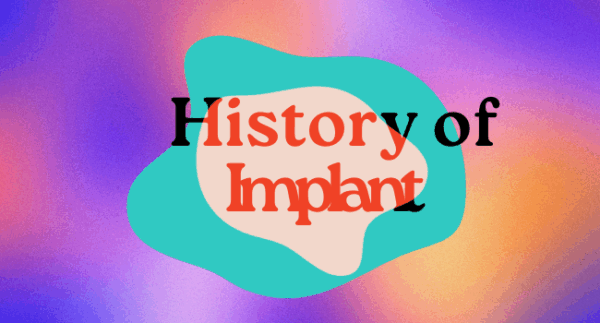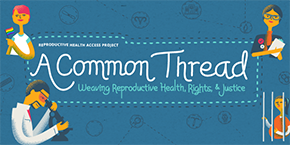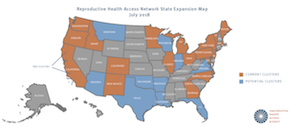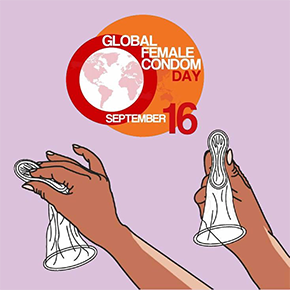Aug 14

Help Us Protect Access to Sexual and Reproductive Health Care Today!
 On September 15, 1821, five Central American nations – Costa Rica, El Salvador, Guatemala, Honduras, and Nicaragua – declared independence from Spanish colonial rule. Fast forward to 1988, when the date was chosen as the starting point of Hispanic Heritage Month to commemorate those anniversaries.
On September 15, 1821, five Central American nations – Costa Rica, El Salvador, Guatemala, Honduras, and Nicaragua – declared independence from Spanish colonial rule. Fast forward to 1988, when the date was chosen as the starting point of Hispanic Heritage Month to commemorate those anniversaries.
The Latinx community is the fastest-growing community in the United States. The social inequalities that they face – including language barriers, low-income paying jobs, and undocumented status – contribute to the quality of health care that they receive. Within the Latinx community, “…91 percent of Latinas who are sexually active and do not want to become pregnant have used some form of contraception. Among all sexually active Catholic women, 89 percent currently use a contraceptive method. Latinas also represent 25 percent of all abortion patients in the U.S. (The Reproductive Health, Rights, and Justice of Latinas: An Imperative for Latina Leadership).”
The Reproductive Health Access Project is proud to highlight trailblazers that are doing their part to combat oppression within the movement in our year-long reproductive justice campaign: “A Common Thread: Weaving Reproductive Health, Rights, and Justice.” You will get to read more about people like Jessica Gonzalez-Rojas, whose leadership at the National Latina Institute of Reproductive Health allows her to organize and elevate the Latinx voice within the reproductive health movement from a grassroots level, and Gloria Malone, the Afro-Latina activist who strives to change the narrative around young parenthood.
 Every quarter, we like to give you a short update on the activities of the Reproductive Health Access Network, our community of reproductive health care primary care clinicians who work nationally and locally to integrate abortion, contraception, and miscarriage care into their primary care settings. Currently, there are 2,100 Network members who live and work in 46 states and Washington, D.C., Canada, and even 11 other countries! Family physicians make up about 65-70% of our Network constituency, with a growing number of internal medicine physicians, nurse practitioners, nurse midwives, physician assistants, adolescent pediatricians, and other specialties represented. Network members come together nationally and regionally at major conferences and also work on-the-ground in 21 states through our Cluster (chapter) structure.
Every quarter, we like to give you a short update on the activities of the Reproductive Health Access Network, our community of reproductive health care primary care clinicians who work nationally and locally to integrate abortion, contraception, and miscarriage care into their primary care settings. Currently, there are 2,100 Network members who live and work in 46 states and Washington, D.C., Canada, and even 11 other countries! Family physicians make up about 65-70% of our Network constituency, with a growing number of internal medicine physicians, nurse practitioners, nurse midwives, physician assistants, adolescent pediatricians, and other specialties represented. Network members come together nationally and regionally at major conferences and also work on-the-ground in 21 states through our Cluster (chapter) structure.
Since our last update, the Georgia Cluster came together for the first time. We also launched a brand-new Cluster in New Mexico! As the Network expands, our Clusters have been able to mobilize in new and exciting ways, pushing their community-based work to new heights. For example, the NYC Cluster recently hosted a physician who has provided medication abortion in Africa to speak to a crowd of at least 50. In Washington state, Cluster leaders invited experts to speak about the potential effects of the Title X “gag rule” in the state. In Ohio, members came together for a happy hour discussion at the annual Ohio Academy of Family Physicians meeting, and in Massachusetts, Cluster leaders led a medication abortion clinical training. Up next is a meeting in Philadelphia, co-hosted with the Women’s Law Project, to discuss the judicial bypass process (and how to work through it) in Pennsylvania. Georgia, Idaho, Maine, Michigan, and Rhode Island are just a few of the other Clusters also planning meetings this fall.
Finally, one of our major ongoing efforts has been to mobilize our family physician Network members to become advocates and leaders within the American Academy of Family Physicians (AAFP). Over the past year, we have identified and are working with about 30 family physicians across our Cluster states (and beyond) who are stepping up to become leaders within the AAFP. These “AAFP Network Liaisons” have successfully given academic reproductive health-related talks, been elected to commissions at the state and national level, and authored at least eight resolutions related to the expansion and protection of reproductive health in family medicine. This fall, we’re sending a contingent of 25 family physicians to the AAFP’s national meeting in New Orleans, where they will present and testify in favor of six reproductive health-related resolutions, attend a leadership development training, and lead or assist with 15 clinical talks on reproductive health care. We are looking forward to yet another busy fall and conference season!
If you are a clinician and would like to join the Network, please sign up here. If you are a provider living in an area where we have a Cluster and would like to be connected, please email Laura Riker, Senior Program Manager, at laura@reproductiveaccess.org.
 On September 16, during Global Female Condom Day, advocates from around the world will be taking action to increase awareness and accessibility of internal condoms.
On September 16, during Global Female Condom Day, advocates from around the world will be taking action to increase awareness and accessibility of internal condoms.
What is an internal/ “female” condom?
While external condoms (also known as “male” condoms) have been in use for over 150 years, an internal barrier method exists as well. The internal condom (also known as the “female” condom) is a great choice for people who prefer to avoid hormones and want protection from sexually transmitted infections. The internal condom can be used for vaginal and anal sex.
The internal condom is a tube with a closed end and flexible rings on each side. The closed side is inserted vaginally or anally. The condom’s external ring can help stimulate the clitoris during vaginal sex.
The internal condom can only be used once – it should be thrown away after use. It has no side effects and is considered a safe non-hormonal method. For pregnancy prevention, it’s 79% effective with typical use. It’s a great option for people with latex allergies, as most internal condoms are made with polyurethane or nitrile. Internal condoms cost about $1.75-$3.50 each.
Every year during World Contraception Day (September 26), activists partake in a global campaign to increase knowledge and access to family planning so that every person can make informed decisions on which contraception method works best for their sexual and reproductive lives.
Over the past year, discussions on internal condom accessibility have grown. As of June 2017, the internal condom manufacturer, Veru Healthcare, now requires a prescription. Unlike external condoms that frequently line the shelves of your local pharmacies and corners stores, making clinicians the gatekeepers of internal condoms further narrows peoples’ access to and familiarity with readily available birth control. Take action today. Contact Veru Healthcare and tell them to make internal condoms (FC2) over-the-counter:
Call: 1-800-274-6601 or 1-305-509-6897
Email: info@FC2.us.com
Tweet: @FC2USA
 September 28 has been recognized as the International Safe Abortion Day since 1990, when Latin American and Caribbean activists banded together on that day to call for the decriminalization of abortion. Now, 28 years later, organizations around the world will mark this day by calling attention to the need for safe and legal abortion.
September 28 has been recognized as the International Safe Abortion Day since 1990, when Latin American and Caribbean activists banded together on that day to call for the decriminalization of abortion. Now, 28 years later, organizations around the world will mark this day by calling attention to the need for safe and legal abortion.
Here in the United States, we have work to do to keep abortion safe, legal, and accessible to everyone both on national and state fronts. Here are three things you can do on September 28th to make abortion safe and legal in the United States:
1. Make sure you are registered to vote! This year’s midterm elections could have a huge impact on the composition of our federal government. Make sure that the candidates running to represent you in the Senate and House reflect your values and vision. All states will allow you to vote in the midterms if you register by September 28. (Most have cut-offs in early October. Find out when the voter registration cutoff date is for your state here.)
2. Let your senators know that you want a Supreme Court Justice who will protect access to reproductive health care. There is no question that the Supreme Court Justice who fills the seat vacated by Justice Kennedy will have a big impact on the future of health care, especially reproductive health care, in the United States. We urge you to learn more about what it could mean for Supreme Court Justice nominee Brett Kavanaugh to have a seat on the Supreme Court. The confirmation hearings start September 4th – help us #SaveSCOTUS.
3. Support state advocates in Alabama, Oregon, and West Virginia who are fighting ballot initiatives that would restrict or prohibit abortion in their state. Learn more about these initiatives and connect with local groups working to preserve access to abortion in these states.
 The Reproductive Health Access Project (RHAP) is now recruiting interns for this fall. Interns play a key role in ensuring that the Reproductive Health Access Project fulfills its mission by supporting the staff of this small but busy organization. We are currently seeking a Development Intern, a Communications Intern, and a Program Intern.
The Reproductive Health Access Project (RHAP) is now recruiting interns for this fall. Interns play a key role in ensuring that the Reproductive Health Access Project fulfills its mission by supporting the staff of this small but busy organization. We are currently seeking a Development Intern, a Communications Intern, and a Program Intern.
Development Intern: We are looking for a highly motivated, organized, and detail-orientated individual to join our team. RHAP expects to continue its growth in the coming years, and the Development Intern will be an integral part of sustaining this growth. This is a unique opportunity to make a significant contribution to an exciting, mission-driven organization. The Development Intern is a part-time intern position reporting to the Development Officer.
Communications Intern: The Communications Intern will help shape and develop RHAP’s voice and message on our online platforms. In particular, the intern will have the opportunity to put ideas into action – educating the broader community on reproductive health access issues and increasing the visibility of the organization. The Communications Intern is a part-time intern position primarily reporting to the Communications Associate.
Program Intern: The Program Intern will play a key role in ensuring that the Reproductive Health Access Project (RHAP) meets it short and long-term strategic goals. This is an exciting opportunity for an enthusiastic, self-starter to work on a variety of local and national initiatives. The Program Intern will be providing support to RHAP’s major programmatic initiatives, including the Reproductive Health Access Network and our Patient Education Materials/Clinical tools. The Program Intern is a part-time intern position primarily reporting to the Senior Program Manager.
You can click here to find more detailed information about these positions on our website.
How to Apply:
Please send a cover letter, resume, and short writing sample to hr@reproductiveaccess.org. Please indicate the position you are applying for in the subject line. Only complete applications will be reviewed. Please no phone calls, emails, or fax inquiries.
More Information:
The Reproductive Health Access Project is an equal opportunities employer. Travel stipends and membership to appropriate member organization will be provided. We are able to offer school credit for undergraduate interns. Although a commitment of 10-15 hours a week is expected, the schedule is flexible. RHAP sponsors all interns to attend the annual Civil Liberties and Public Policy (CLPP) conference in the spring at Hampshire College.
Your gift allows us to train and support health care providers across the United States so they can offer patients compassionate and comprehensive care.
Aug 14
